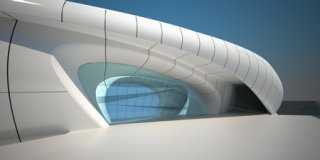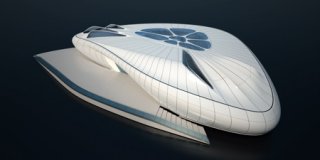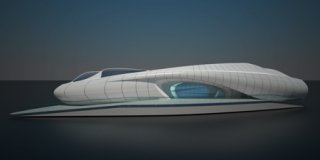There are many minor cities in China with populations of six and seven million, so perhaps it is natural that Hong Kong always feels like a small town. A tiny circle of storied capitalists and their socialite spawn sit at the center of a node in the global economy unlike any other. The local art scene does nothing better than organize panel discussions about its own shortcomings. Vague apparitions of the future—stalled plans for the West Kowloon Cultural District, a controversial Herzog & de Meuron design for an arts district amid a redeveloped police station and prison compound in Central—play to the idea that this is a city where big things could happen. For now though, it’s a place where one goes to bemoan how global capitalism has made the world into a giant mall, but also to buy a really fabulous suit or bag.
And oh, the shopping! The late critic Jonathan Napack once noted how the town “went directly from feudal poverty to postmodern consumerism without an intervening stage of ‘modernity.’” So perhaps there was no other place for
Karl Lagerfeld and
Zaha Hadid to kick off their plan to bring “mobile art” to five global cities, with a traveling exhibition installed inside a reverie by Lady Zaha herself, easily collapsible and transportable from one stop on a jetsetting trajectory to another.
If anything, the Chanel container, which opened to the public on February 27 for visits at rigidly enforced fifteen-minute intervals, provided a chunk of cultural capital that natives and visitors (never an easy distinction in Hong Kong) could play off each other. The production values are as high as one would expect, and the theater of the container’s vaguely Eurasian hostesses in matching black Chanel knit cloaks and white pants regulating entry, then presenting as fetish object the MP3 player that contains the exhibition sound track, was priceless. “Which language would you prefer?” they asked each visitor. “We have English, French, and four Asian languages.” Inside,
Yang Fudong’s two-screen still video depicting a pair of aloof beauties seemed to capture and satirize the desired aesthetic, although
Wim Delvoye’s no-holds-barred fabrication of a Chanel quilted bag (supposedly Hadid’s inspiration for the container itself) from his Beijing-bred tattooed pigs came in at a close second. Looking into an animated pit by last summer’s Venice star
Tabaimo, one was warned by the husky baritone of Jeanne Moreau on the MP3 player: “There are secrets lying at the bottom of a well, just like in the bottom of a bag.” Not that I had higher hopes, but it was at this line that I had the Vestals switch my player to Mandarin, resigned to anthropological curiosity about how such inanities would be rendered in the language of the brand’s biggest, newest market.
“What did you think of the Chanel exhibition?” and “Are you going tomorrow?” were the parlor questions of the evening before the opening gala, as I sat on the fifteenth-floor roof deck of the China Club late last Tuesday, glimpsing out toward the Star Ferry car park where the container was installed. Artists and curators began to appear—
Michael Lin, Loris Cecchini, Fudong, Fabrice Bousteau, Wu Shanzhuan, MASS MoCA’s Joe Thompson—and mingled with daughters of the major families, girls with American first names and surnames like Woo and Chou. There were four eminent lacquer craftsmen on that roof, three members of the Koolhaas family in from Guangzhou (“A great town, full of pink buildings and African clubs,” exclaimed Charlie), and even leading 1980s critic Pi Daojian, now better known as the father of Beijing gallerist Pi Li. In a nearby room, Club founder Sir David Tang held court with Hadid and Project Runway’s Nina Garcia (in town to promote—at Lane Crawford, of course—a new book urging women to be less brand conscious). The latter duo was complemented by a rotating cast of notables shepherded in for individual audiences by Tang’s longtime collaborator, the dealer Johnson Chang. For a brief moment, the Club’s dynamite collection of Chinese contemporary art, assembled by Chang and Tang in the early ’90s as they essentially wrote the playbook that the auction houses still follow today, seemed worth every dollar it would bring if put on the block tomorrow.
Fashion parties happen every week in Hong Kong (by all accounts the Louis Vuitton event two nights later was “so much better”), but fashion parties with the veneer of art—that is another story entirely. And for Chanel, art was as good a reason as any to enforce that key brand attribute: exclusivity. Just ask the executive director of one of the city’s major art institutions (herself also a fixture of local party rags like
Tatler and
Prestige) who was invited explicitly sans husband (the Asia director of a competing brand). “It was all just a little too precious,” she said on the roof of the China Club. Another friend with deep family ties to the fashion industry got her invitation only after a guilt-tripping call from a publicist explaining that she would be allowed in—but only in place of a Chanel executive who had flown in just for the event from Paris.
It was this friend with whom I arrived, walking unsuspectingly before the paparazzi with her and an
Artforum colleague—until we two guys were kindly asked to move over so that the dog-catchers (as they’re called in Cantonese) could shoot “just her look, please.” Hand-stamped and inside, we were reminded of Akbar Abbas’s pithy formulation about Hong Kong as the land of the
déjà disparu, a place with no visible past, or even Napack’s idea of the city as the “apotheosis of the bogus.” Why was it so empty? Had people been already and left? Had Chanel gone so far in the name of brand exclusivity that no one actually felt like showing up? We mitigated this curiosity by frequent vertical moves from the party scene downstairs to the container-bearing rooftop, exchanging empty champagne glasses for full ones with every climb. At one point Lagerfeld and Hadid arrived, but it seemed the only people left to notice were photographers paid to do so. Charlie and Rem D. Koolhaas ran downstairs to say hello to their old family friend, as we blew kisses and agreed to meet again a week later in Dubai.









